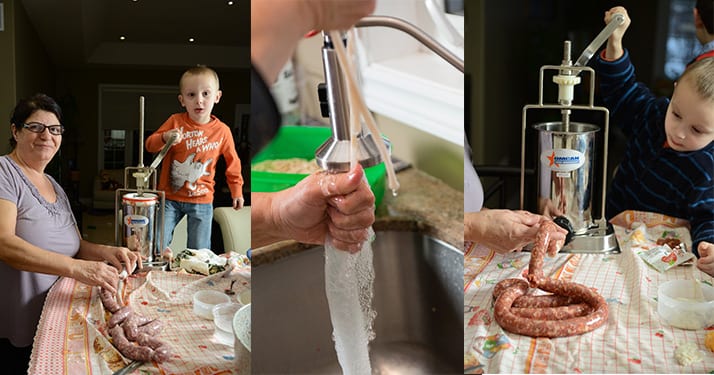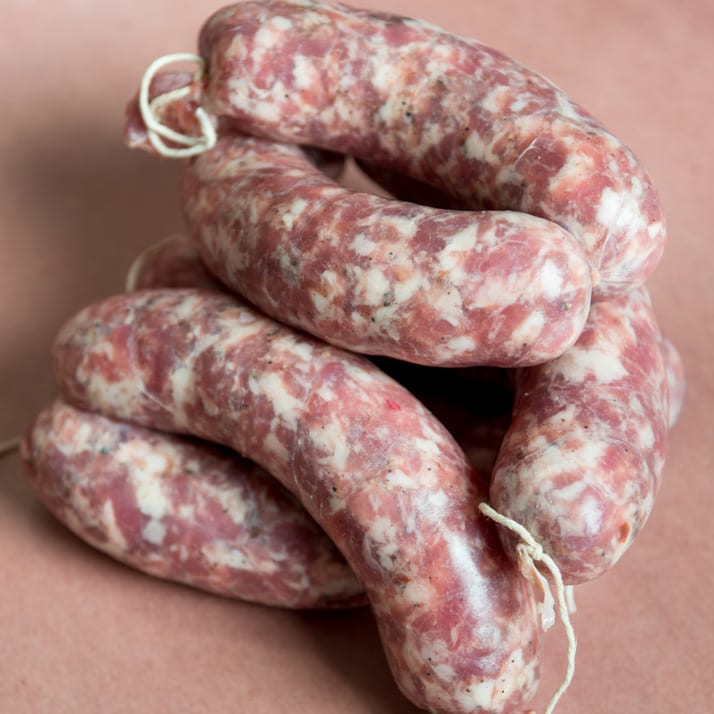Sausage Making Time!
It’s that time of year again, sausage making time! Sure, you can buy sausage and salami in the store but once you’ve had homemade you’ll never go back! My nonno always raised a couple of pigs on the farm so this was always an exciting time of year. I was lucky enough to be in Italy a few times to experience “pig days”. One year, between nonno and nonna and uncles and aunts, there were 7 pigs! It was a lot of work, but a lot of fun too. We would start the fire around 5am, get everything ready and then nonno and compare Micu would guide the way. First thing while the pig was hanging, nonna would collect the blood for blood sausage or sanguinazzo – not my thing but a big tradition. Special cuts were saved to make cured meat, and the rest was ground for salami. What we Canadians treasure as bacon was saved as an entire piece to be cured with salt and hot pepper flakes, part of the shoulder becomes capicolla and of course the leg is the prosciutto – although my nonno always went for more salami than prosciutto. I’m guessing it’s because in the south where my family is from the winters are too short and warm and there are no basements or coldrooms to attempt the long curing time of a ham. An abundance of hot salamis, sopressata, nduja and bacon, however, would hang in my aunt’s house. At the time, she had an old house in town that was once a butcher shop with a side room that remained nice and cool and still had a railing system for hanging meats! Luckily, it wasn’t the dining room:)
There was no waste I can tell you that much. Everyone waited anxiously for the ‘caldara’. All the bones and skin that have a bit of meat on them are cooked for hours in a huge pot and then enjoyed by young and old. At the end of it all, my nonna and zia Angelina would render all the remaining fat to make soap. No, I didn’t mean to say soup, really, SOAP! Unfortunately, they have both passed on and nobody ever thought to document exactly how to make it. I am determined to find someone who still does it though and as soon as I do, you will find it here on Nonna’s Way! It was great soap that took out absolutely any stain imaginable.
Anyway, back to sausage!….
We have the luxury of going to a store and purchasing whatever cut of meat we like and foregoing all the work of raising and killing a pig! Whether you’re going to an organic farm and purchasing half a pig or to your local grocer for shoulders and legs, now is the perfect time. We are going to show you one nonna’s way here but trust me, there are many different recipes out there and like everything else in Italy, they may change from town to town!
Fresh Sausage.

We start out by taking our pork shoulder and/or leg and trimming off the skin, leaving an eighth inch of fat on attached to the skin. Set that aside for certain types of cured sausage like nduja or discard and continue cutting the meat against the grain into small chunks that easily fit into the meat grinder. If there is a lot of fat you can trim some off and set aside for making nduja which we will cover next. You do need some fat in sausage so don’t trim off too much. Once complete, run the meat through the meat grinder with a number 10 or 12 grinder plate (courseness of grind). Here we use a number 12 and are making three types to show you so we split the ground meat into three 10-pound portions.
(If you don’t have a meat grinder most large grocers or butcher shops will gladly grind the meat for you).
Nonna Pina’s Calabrese mild sausage is very very simple; 10 pounds ground pork, 5 tablespoons coarsely ground black pepper and 4 tablespoons of sea salt. Mix it all together and cover. You can stuff the casings right away or let the mixture sit overnight.
Calabrese hot sausage: 10 pounds ground pork, 5 tablespoons coarsely ground black pepper, 5 tablespoons sea salt, and 6 tablespoons of hot chili flakes or ‘peppe stato’.
Nonna Pina’s hot sausage: 10 pounds ground pork, 5 tablespoons coarsely ground black pepper, 5 tablespoons sea salt and 18 tablespoons of ground hot red peppers (fresh peppers finely chopped in a food processor).
It’s always a good idea to fry up a little after mixing the meat and taste it to make sure you are happy with the seasoning. What’s mild or hot for one family may not be for another.
While the ground seasoned meat rests in a cool place, you can wash the sausage casings and prepare the sausage stuffer. Most casings will come cured in salt so you want to let them soak in a bowl of water with a slice of lemon to dissolve the salt. Rinse them with cold water and run water through the casing as well. You can stuff using the same system that ground the meat or use a nifty apparatus made for the purpose of stuffing sausage. If it’s something you think you will do every year it is worth investing in good machines. Places like Consiglio Kitchenware and Nella Cutlery in our area are great places to find all these specialty items.
You can see above that we used different size casings. For links of sausage you want regular sausage casings. For skinnier sausage to make a wheel of sausage or ‘Barese’ style sausage you want sheep casings. Both are great. Regular sausage casings are the norm but if you can get sheep casings try it out! The casings go on the stuffer tube by placing one open end over the tube and sliding it on little by little. It helps to have a tiny bit of meat poking through the tube to help the casing slide on. Keep one hand on the end of the tube so you can feel when the casing is stuffed and the other ready to move the sausage along or twist into links. Overstuffing or stretching the casing too much will cause it to break, but no problem, tie it off with some string and keep going. You’ll get a feel for it right away.
Once complete, all that’s left is to seperate the sausage into meal portions and freeze. You can tie off ends and place your portions in seperate packs or freeze twisted links on a cookie sheet and then once frozen cut through each twist and freeze in a large ziploc food safe bag as single links so you can take what you need each time.







Sorry, the comment form is closed at this time.